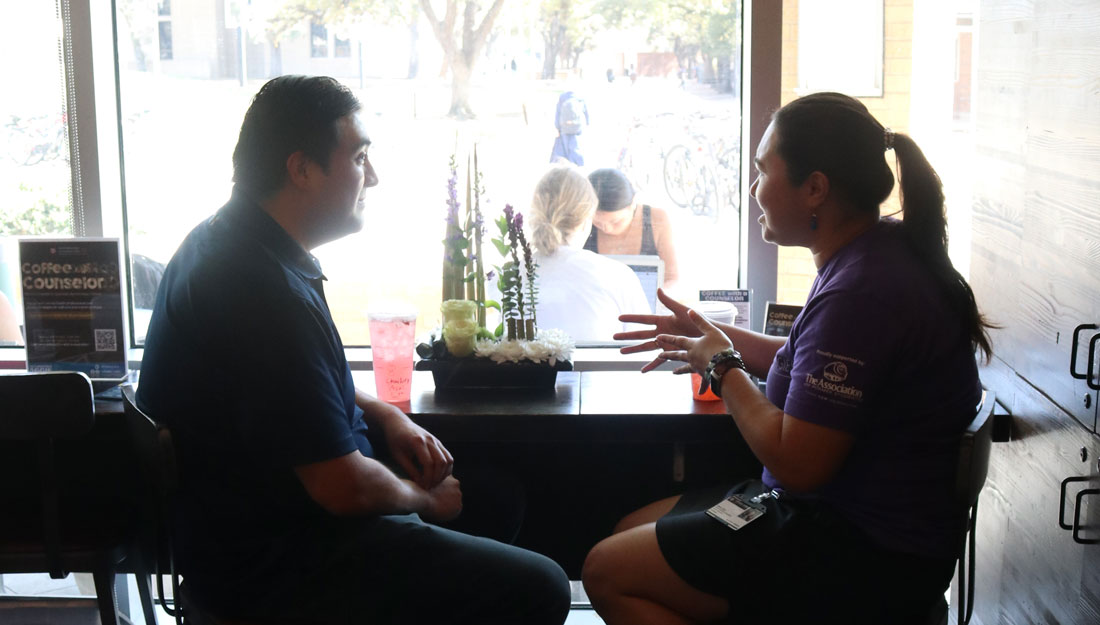- Laura Tolentino
- Community, Show on VR homepage, University Health Services
Collegiate Recovery reframes the Aggie experience
Aggie Recovery Community brings sobriety within reach for students struggling with addiction

Aggie Recovery Community offers recovery coaching and recovery-oriented meetings, peer-to-peer process groups, meditation groups and exclusive access to Rudder Tower facilities and amenities, offering a safe space for students recovering from addiction. (Stock image)
On the tenth floor of Rudder Tower, picture windows line the Aggie Recovery Community facility in College Station, overlooking a bustling Texas A&M University campus. Crowds mill around Rudder Plaza, where tables display student resources. The Memorial Student Center sees a continual stream of passing students. And Kyle Field towers over all. It’s a classic view of Aggieland. But for students frequenting Aggie Recovery Community, theirs has not always felt like a classic “Aggie experience.”
While all students at Texas A&M face the sometimes daunting prospect of balancing academic and social commitments with their health and wellbeing, students struggling with addiction find these pursuits laced with additional challenges and pressures. Some traditional Aggie pastimes may be frequently paired with activities like social drinking, said John Shiflet, director of collegiate recovery at University Health Services. Pursuing an alternate path sometimes comes at the cost of community engagement for students seeking sobriety.
“There’s still a lot of negative stigma around addiction, even recovery,” Shiflet said. “People in recovery don’t talk about their addiction or their recovery with non-addicted individuals for fear of judgment.”
Aggie Recovery Community strives to reframe the Aggie experience for its student participants, embracing a culture of sobriety as part of the traditions and values of Texas A&M.
Framing the challenge
For students grappling with addiction, Aggie Recovery Community provides resources and fosters community to assist in fully embracing campus life. This extra layer of university support directly contributes to increased retention and graduation rates, said Lanice Bennett, director of strategic initiatives and partnerships at University Health Services.
“The whole point of collegiate recovery—and for Aggie recovery—is because we want a student to have the Aggie experience and sobriety, and they should not have to choose between those two,” Bennett said.
Marking its first operational semester with an opening celebration on Friday, Oct. 18, the Aggie Recovery Community offers recovery coaching and recovery-oriented meetings, peer-to-peer process groups, meditation groups and more, with current offerings listed online at tx.ag/uhsrecovery.
Already, 15 Texas A&M students have applied and been welcomed as Aggie Recovery Community members, gaining exclusive access to Rudder Tower facilities and amenities, including study carrels, kitchen facilities, and community relaxation spaces complete with couches, a ping pong table, an arcade game, and a projector with a big screen.
“This is a safe space,” Shiflet said. “And this space is here for you to use and grow in your recovery. This is a community you can depend on and rely on to support you unconditionally. This is a program that is going to help you achieve your goals. And most importantly, this is a program that is going to provide you the complete Aggie experience.”
Picturing success in recovery
Community connection and support already have begun to grow roots beyond Rudder Tower, Shiflet said, with several Aggie Recovery Community members electing to socialize and attend football games together. These organic extensions of the Aggie Recovery Community create expanded opportunities for students to engage in campus life while successfully pursuing sobriety amongst supportive peers.
“We’re here to have fun, we’re here to grow together, we’re here to cry together, we’re here to get through the hard times together, and you never have to be alone again in this fight against addiction,” Shiflet said.
For Shiflet, as collegiate recovery staff fill critical roles in facilitating opportunities and offering support, these student-initiated gatherings are early and clear markers for success in collegiate recovery.
“I’m there to support students,” Shiflet said. “But really, what success looks like in a collegiate recovery program is when the students are doing the heavy lifting. They’re doing the work. They’re supporting one another.”
Enduring family portraits
Long term, Bennett said she anticipates the success of Aggie Recovery Community to reap cycle-breaking benefits that ripple through generations of Aggie families.
“They get that ring, and they get that piece of paper in their hand, and they graduate and change their family line,” Bennett said. “Anyone who maybe thought they couldn’t have done it, now they can. And that not only gives them that degree; it changes their family line going forward, because now they’re college-educated, and that can change the course of their generations below them.”
Even as Aggie Recovery Community navigates its first operational semester, this fall, the Aggie family has extended overwhelming support, Shiflet said. Former students have reached out individually to emphasize the need for a recovery community at Texas A&M. Aggie Moms have donated supplies and volunteered to propel the Aggie Recovery Community toward success.
Bennett said Texas A&M University Chancellor John Sharp ensured Aggie Recovery Community gained access to critical funds and resources to launch its mission
“It’s been amazing,” Bennett said. “The support we got was overwhelming. To continue to see how many people have supported this program—and getting it off the ground and understanding that this is something that we have needed—has been phenomenal.”
The big picture
With support and momentum growing daily, Bennett said University Health Services already is eyeing opportunities for partnership and expansion to better serve Texas A&M students throughout the Texas A&M System.
Among those efforts, groundwork is being laid for an educational program, designed to spread awareness and teach foundational skills for Aggie community members seeking to support friends and loved ones struggling with addiction.
“It is very hard to find someone who has not been touched by addiction in some way,” Bennett said. “They, themselves, are in recovery; they have a loved one who has fought with addiction; or they have lost someone who has battled addiction; and it’s a painful, awful disease. This program is meant to give hope, and that is why we are so excited about it.”
Beyond main campus-focused efforts, Aggie Recovery Community stands poised to serve as a flagship, sharing resources and insight with additional recovery communities being explored on other Texas A&M campuses. Conversations already have begun to discuss ways Aggie Recovery Community might provide even more layers of direct support to specific populations of students at risk for addiction, including veterans, Bennett said.
A snapshot of Aggieland
Prior joining Texas A&M, Shiftlet spent a decade serving as a director of collegiate recovery at the University of Houston. He said this wave of support for recovery at Texas A&M represents an unprecedented response to a culmination of tireless efforts on multiple fronts, including yearslong campaigns by Aggie Moms to bring recovery services to Texas A&M. With University Health Services piloting Aggie Recovery Community, Shiflet seeks to unite various supporting factions for maximum student impact.
“In the field of collegiate recovery — this program — it’s unprecedented, how it has started,” Shiflet said. “Most programs have to fight for funding. They have to fight for space. And here, it didn’t come easy. There was a lot of hard work and conversations for many years to get us where we’re at, now. Once John Sharp said, ‘Let’s do this,” it happened really quickly, and it happened in a big, big way, too.”
As he focuses on translating this influx of support for collegiate recovery at Texas A&M into programmatic success, Shiflet said the future is bright for students seeking recovery at Texas A&M. From the tenth floor of Rudder Tower, Aggie Recovery Community members find themselves surrounded by resources and support, punctuated by the picture window scenes of an Aggie Family rallying to their aid. For Shiflet, the view is clear from here:
“Texas A&M is an amazing institution; they do things big,” Shiflet said. “And I really believe this program has the funding and the backing and the support by the institution that it really could be one of the biggest programs and one of the best programs in the country. Texas A&M is going to be who other institutions look to, when they want to implement collegiate recovery programs at their institution.”
Media contact: media@tamu.edu


